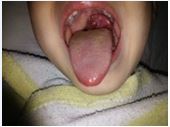Clinical-epidemiological characterization of lymphomas on pediatric ages in Pinar del Rio, 2010-2016
Keywords:
MORBIDITY, LYMPHOMA, NON-HODGKIN/complications, PEDIATRICS. lications, PEDIATRICS.Abstract
Introduction: lymphomas represent the third neoplasm in order of frequency in pediatric ages. Many cases are diagnosed in advanced stages of the disease in spite of the efforts the health system makes. However, in this province no studies contextualizing the local reality of this disease have been conducted.
Objective: to characterize some clinical-epidemiological variables in lymphomas.
Method: a non-experimental study was carried out following a quantitative methodology. On the design of this research the scientific variables used were controlled by the researcher to be analyzed as an observational, descriptive, retrospective and cross-sectional study conducted in the service of onco-hematology at Pepe Portilla Provincial Pediatric Teaching Hospital from January 2010 to January 2016.
Results: a similar behavior regarding the number of non-Hodgkin's lymphomas diagnosed per years was observed; during 2015 no diagnoses were conducted. A similar behavior was found in both genders regarding the diagnoses performed. Ages from 7 to 12 and 13 to 18 prevailed for female gender, along with 1 to 6 and 13 to 18 for males. Burkitt's lymphomas was the most prevailing histology, anaplasia type was not diagnosed. The most frequent localization was in the abdomen. More of the half of cases was diagnosed in stages III-IV of the disease; despite of this, the greatest number of sufferers received a complete response concerning the treatment.
Downloads
References
1. Madero L, Lassaletta Á, Sevilla J. Hematología y Oncología
Pediátricas.3a.ed. Madrid: Ergón; s/a.; 2015.
2. Ward E, DeSantis C, Robbins A, Kohler B, Jemal A. Childhood and adolescentcancerstatistics, 2014.CA Cancer J Clin [Internet] 2014 Mar-Apr [citado 2016 jul 15];64(2):[Aprox. 10 p.]. Disponible en: http://www.ncbi.nlm.nih.gov/pubmed/24488779
3. Noone AM, Krapcho M, Garshell J, Neyman N, Altekruse SF, Kosary CL. Childhood cancer by the ICCC In: Howlader N, Noone AM, Krapcho M. SEER Cancer Statistics Review, 1975-2010. Bethesda, Md: National Cancer Institute [Internet] 2013 [citado 2016 jul 15]. Disponible en: http://seer.cancer.gov/archive/csr/1975_2010/results_merged/sect_29_childhood_cancer_iccc.pdf
4. Instituto Nacional del Cáncer. Linfoma no Hodgkin infantil: Tratamiento. Instituto Nacional del Cáncer de los Institutos Nacionales de la Salud [Internet]. 2016 [citado 2017 abr 18] Disponible en: https://www.cancer.gov/espanol/tipos/linfoma/pro/tratamiento-lnh-infantil-pdq
5. Longchong Ramos M. Enfermedades oncológicas Generalidades del cáncer infanto-juvenil. La Habana: ECIMED; 2016.
6. Smith MA, Altekruse SF, Adamson PC. Declining childhood and adolescent cancer mortality. Cancer [Internet]. 2014 [citado 2016 jul 15]; 120 (16):[Aprox. 14 p.]. Disponible en: https://www.ncbi.nlm.nih.gov/pubmed/24853691?dopt=
7. Puente Saní V, Oropesa Roblejo P, Caballero Artiles RA. Linfoma no-Hodgkin en un paciente con sida. MEDISAN [Internet]. 2016 Jun [citado 2017 abr 18]; 20(6): [Aprox. 11 p.].Disponible en: http://scielo.sld.cu/scielo.php?script=sci_arttext&pid=S1029-30192016000600010&lng=es.
8. Fajardo Gutiérrez A, Hernández Cruz L, Garduño Espinosa J, Mejía Aranguré JM, Mendoza Sánchez HF, Martínez, García MC. Epidemiología descriptiva de las neoplasias malignas en niños. RevPanam Salud Publica [Internet]1999 [citado 2016 jul 15];6(2):[Aprox. 12 p.]Disponible en: http://www.scielosp.org/pdf/rpsp/v6n2/a1.pdf.
9. Arias M, Godoy J, Maya LC, Vásquez P, Suárez A. Caracterización de los pacientes de una Unidad de Cuidado Intensivo Pediátrico exclusivamente oncológica. Revista Colombiana de Cancerología [Internet] 2015 [Citado 2016 jul 15]; 19(2):[Aprox. 10 p.] Disponible en: http://www.sciencedirect.com/science/article/pii/S0123901515000268
10. Verdecia Cañizares Caridad, Santos Labarcena María Elena, Lam Díaz Rosa María. Comportamiento del linfoma no Hodgkin en la edad pediátrica. Rev Cubana Pediatr [Internet]. 2015 Dic [citado 2017 Abr 18]; 87(4):[Aprox.7p].Disponible en: http://scielo.sld.cu/scielo.php?script=sci_arttext&pid=S0034
.
11. Swerdlow SH, Campo E, Pileri SA, The 2016 revision of the World Health Organization classification of lymphoid neoplasms. Blood. 2016[citado 2017 Abr 18]; ; 127 (20): [Aprox.15p]. Disponible en: http://www.bloodjournal.org/content/127/20/2375?sso-checked=true
12. Vela E, Cruz O. Linfomas. En: Cruz M. Tratado de Pediatría. t-2. España: Editorial Médica Panamericana; 2013. p.
13. Iglesias Echeverría A, Gómez-Sosa K, Álvarez Suazo T, Alcantara López S. Linfoma no Hodgkin en Pediatría y su Debut como Emergencia Oncológica: A Propósito de un Caso. Archivos Medicina [Internet]. 2016 [citado 2017 abr 18]; 12(2):[Aprox. 11 p.]. Disponible en: http://www.archivosdemedicina.com/medicina-de-familia/linfoma-no-hodgkin-en-pediatria-y-su-debut-como-emergencia-oncologica-a-proposito-de-un-caso.php?aid=9695.

Published
How to Cite
Issue
Section
License
Authors who have publications with this journal agree to the following terms: Authors will retain their copyrights and grant the journal the right of first publication of their work, which will be publication of their work, which will be simultaneously subject to the Creative Commons Attribution License (CC-BY-NC 4.0) that allows third parties to share the work as long as its author and first publication in this journal are indicated.
Authors may adopt other non-exclusive license agreements for distribution of the published version of the work (e.g.: deposit it in an institutional telematic archive or publish it in a volume). Likewise, and according to the recommendations of the Medical Sciences Editorial (ECIMED), authors must declare in each article their contribution according to the CRediT taxonomy (contributor roles). This taxonomy includes 14 roles, which can be used to represent the tasks typically performed by contributors in scientific academic production. It should be consulted in monograph) whenever initial publication in this journal is indicated. Authors are allowed and encouraged to disseminate their work through the Internet (e.g., in institutional telematic archives or on their web page) before and during the submission process, which may produce interesting exchanges and increase citations of the published work. (See The effect of open access). https://casrai.org/credit/


